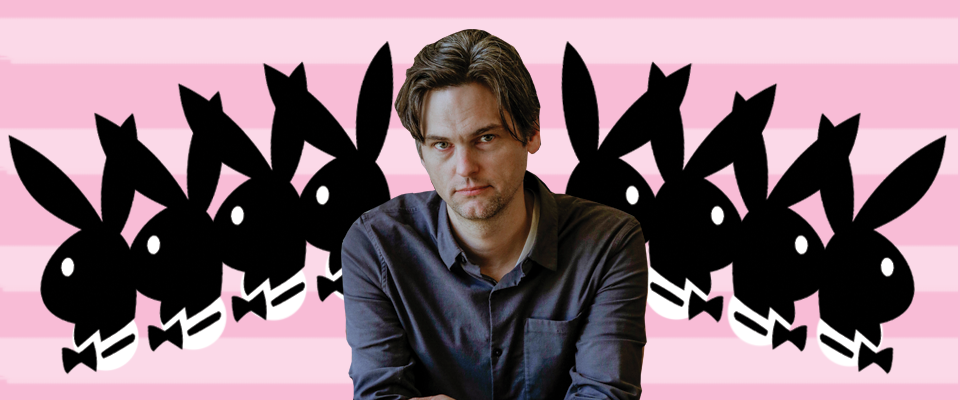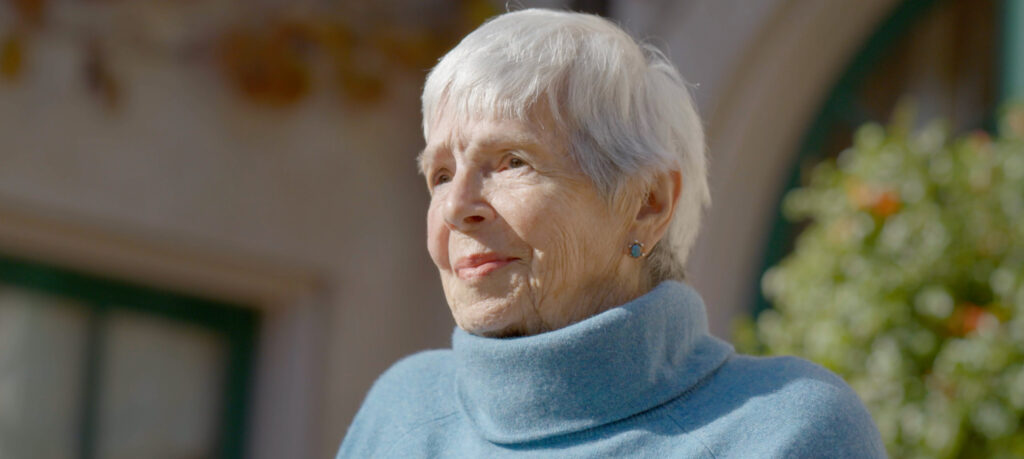A visitor walks between Roc Nation and United Talent Agencies until she reaches the heavy glass doors of a beige building in a Beverly Hills office park: once inside, she tells the lobby attendant she has an appointment with Playboy magazine. If the visitor has an A cup and a complexion that can be accurately described as “dapple-gray,” the attendant will still permit her to access the elevator, provided the visitor has an appointment. (Fortunately, I did.) The attendant will not laugh; this is a city of dreamers.
Upstairs in Playboy’s reception, Hugh Hefner, who has been dead for months, feels quite present, what with the translucent circular stairway hovering over a pool of crystals, the zebra-print chairs, the framed nudes. The staff has just closed an issue of the magazine and most are celebrating at a nearby restaurant; Cooper Hefner, Hef’s 26-year-old son and the magazine’s chief creative officer, and a few others are having a drink at the office lobby’s well-appointed bar; James Rickman, the magazine’s executive editor, says Thursdays used to be crazy around here, what with all the Playmates and friends stopping by, but they’ve been quiet lately.
The years Rickman has been at Playboy have been hectic. Hef died, the magazine reinstated the nudity it’d briefly sworn off, and almost the entire leadership team changed over.
Rickman is delicate: tall and thin with deep-set eyes, a slow, enunciated speaking style, and a career journalist’s tics. When he disagrees, he’ll ask a follow-up question instead of pressing his own point. “I don’t consider myself a vision person; I won’t even use the word visionary, except there, when I just did,” he says in response to a question about his goals for the magazine. “I’m not a talker. I’m very self-conscious and I didn’t participate in seminars,” he said of his time as an undergraduate at UC Berkeley. “You kept a low profile at University,” I offer. “The lowest of profiles,” he responds with a hint of pleasure. “No profile at all.” He describes his career ascent as “fading in.”
Rickman came to Playboy from PAPER Magazine, where he started as a contributor and gradually worked his way up. He was the managing editor on its famous “Break the Internet” issue, wherein a shiny Kim Kardashian popped champagne into an expectant coupe settled on her backside. He left New York City because it was time, he says; he’d been there for 13 years. Rickman didn’t expect to find a staff job working in magazines again, let alone at Playboy, just two months after he moved to L.A. But a friend sent him the listing and he figured he’d take the interview when he got one. Rickman joined as a senior editor and was promoted to executive editor a year later. He thinks that in appointing him to lead, Playboy’s board was trying to take steps away from the “frat-boy stereotype that had started to settle in around the brand.” There, they did well; Rickman reads as considerate and kind, the antithesis of a frat boy.
The two and a half years Rickman has been at Playboy have been hectic. Hef died, the magazine reinstated the nudity it’d briefly sworn off, and almost the entire leadership team changed over. Meanwhile the print magazine, like so many other paper-and-ink publications, continued to hemorrhage readers and revenue.
++++
On January 1st, Playboy Enterprises’ chief executive told the Wall Street Journal that the company was going to spend 2018 transitioning “from a media business to a brand-management company.” Anyone can tell you the media business isn’t much of a business, but it’s hard to argue against the value of Playboy as a brand.
Since its founding 65 years ago, Playboy has been known for two things: literary flair and female flesh.

It was home to legendary interviews with such luminaries as Martin Luther King Jr., Malcolm X, John and Yoko, Jimmy Carter, and Steve Jobs. The magazine broke classic fiction by John Updike, Haruki Murakami, Doris Lessing, Vladamir Nabokov, Anne Sexton, Kurt Vonnegut, and others. Ray Bradbury famously serialized Farenheit 451 in its pages. Playboy continues to run substantial, reported pieces on politics, entertainment, and culture; its latest issue contains features on toxic masculinity support groups and how working women organize.
This enlightened editorial coverage exists uneasily alongside the magazine’s visual assets: photos of hot, usually ample-bosomed women posed nude but for some incongruous accessory (a lariat, or a cardigan). It’s hard to put a finger on when Playboy began feeling dated, but Hef’s mid-2000s reality show, filmed at the mansion, certainly didn’t help. Having multiple young girlfriends, as it turned out, was quite a bit tackier than the fantasy. The women bickered; they told all; they moved on. And the magazine fell out of step with the culture, as any pimply kid with a Wi-Fi connection could now pull up hardcore hentai porn in ten seconds.
When Hef died, major news outlets sent push notifications to smartphones around America. The New York Times ran both a traditional obituary and an opinion piece, the latter of which called him a “lecherous, low-brow Peter Pan, playing at perpetual boyhood.” Many of us settled between the praise and the criticism, having never figured out quite what to make Hef; whether he was a subversive, a sleaze, or both; whether the work he’d done mattered seriously, symbolically, or superficially.
Rickman’s own family is split on the social merits of the magazine, while Rickman views the debate with a studied remove. “I’m fascinated by the Rorschach test that is Playboy,” he says. “All I can do is embrace a certain amount of complexity and allow that all those reactions are genuine and there have always been critiques of Playboy that are totally valid. We’ve been fighting with Gloria Steinem since our inception. We love Gloria Steinem.” The magazine’s great virtue, Rickman says, is that it gets people talking.
++++
Rickman walks a tightrope in this tricky media moment, where movements toward body positivity and away from sexual objectification present real challenges to centerfold magazines. Sports Illustrated recently tried to catch the cultural wave by painting words like “nurturer,” “feminist,” and “environment” on its female models’ nude bodies, a transparently kiss-ass move met with yawns and eye rolls. Playboy has at least dropped the excessive airbrushing; one Playmate has visible stretch marks and you can make out the faint outline where another’s belly-button ring used to be. The women are still stylized—in the most recent issue, one is posed as a woman from the future, another leans across the edge of a pool—but they’re no longer big wig, big makeup, uniform big tits ultra-stylized.
No doubt these female models are still sexualized for a largely-male audience, but Rickman contends the magazine and #MeToo are working hand-in-glove. He calls #MeToo one of the most important moments in the history of sexual liberation, a goal he believes Playboy has furthered over the years. He also points to the “vast ecosystem of erotic photography” on Instagram as evidence that women enjoy looking at beautiful women at least as much as men do.
And while Rickman resists saying too much about the magazine’s future, which he calls “unclear” and “totally unknown,” he doesn’t want to see the print magazine fold. For one, Playboy’s trademark feature wouldn’t survive the shift. “Of all the great and worthy magazines that have shut down or are shutting down, Playboy is unique in that the centerfold is something that will only exist in print,” Rickman says. “Until there is a Playboy VR experience, you can’t replicate that digitally. There’s something very profound about that centerfold. I think it would be a great loss in the small pleasures of life.”
Melissa Batchelor Warnke—a graduate of the UC Berkeley School of Journalism—covers gender, politics, and culture. She is currently an editor at Girlboss. Her work has appeared in The Los Angeles Times, VICE, The Washington Post, and other publications.





















